ABSTRACT
This article considers discourse-initial fragments such as A coffee, please. The article argues against “sententialist” analyses of such fragments which propose that they are elliptical for fully-fledged syntactic structures, but also argues that DP fragments are not strictly “what-you-see-is-what-you-get” either. Rather, a small amount of unpronounced syntactic structure is present in such fragments – a null head, crucially not verbal but rather something more akin to a preposition, which introduces an event argument and assigns a thematic role to the DP fragment. This is argued to account for a number of otherwise mysterious (on the sententialist view) properties of antecedentless fragments, in particular some surprising cases of ungrammatical antecedentless fragments.
1 Introduction
This article considers the phenomenon of antecedentless fragments: utterances which can be felicitously used discourse-initially, and which (appear to) lack sentential syntactic structure, in particular a verb, but which nevertheless are interpreted as fully-fledged speech acts, as in (1).
(1) a. [In a taxi.] To the train station, please.
b. [In a café.] A coffee, please.
c. [Admonishing a child holding a bowl of soup unsteadily.] Both hands.
The correct analysis of such fragments has been argued to have crucial implications for the faculty of language and its interaction with other cognitive domains. The key issue at stake, outlined at book length in Stainton (Citation2006b), is whether such fragments “basically” denote only what they appear to – entities, generalized quantifiers, properties, etc. – and receive propositional interpretations by means which are external to the language faculty as such (the nonsententialist view, or “what you see is what you get”); or whether fragments like (1) should be taken to underlyingly be elliptical for fully-fledged sentences (despite the lack of linguistic antecedent for such ellipsis) – e.g., take me to the train station please – thereby receiving a propositional interpretation fully internal to the language faculty, the so-called sententialist view defended in, e.g., Stanley (Citation2000); Merchant (Citation2004); Ludlow (Citation2005). Such fragments have also played a role in the analysis of fragments which do not appear discourse-initially (and therefore do have a linguistic antecedent for putative ellipsis), e.g., What would you like? – A coffee; see Merchant (Citation2004) and Weir (Citation2014).
This article proposes an analysis of antecedentless fragments which charts a middle path between the “fully nonsententialist/WYSIWYG” view and the “fully sententialist/elliptical” view. In common with the nonsententialist view, I hold that antecedentless fragments like (1) do not contain “elided” structure in the sense of Hankamer and Sag (Citation1976)’s surface anaphora; that is, there is no structure that goes unpronounced under identity with some antecedent. In particular, there is indeed no verb in such structures. But, at least in the case of apparently bare DPs such as (1b, c), neither are they purely “what you see is what you get”; there is a small amount of (silent) syntactic structure which provides “just enough” semantic structure – an event argument and a thematic role for the DP – to deliver a propositional interpretation. The key piece of evidence for this comes from the fact that such DP fragments can be modified by adjuncts which semantically modify events, as in (2).
(2) a. A coffee for me, please.
b. A coffee now, please.
c. My kingdom for a horse!
I argue that this “small” amount of syntactic structure is crucially not verbal, but something more akin to a (null) preposition. I will show that this accounts for a number of otherwise mysterious (on the sententialist view, and to an extent on the nonsententialist view as well) properties of antecedentless fragments, in particular some surprising cases of ungrammatical antecedentless fragments. While the paper focuses mostly on English, the analysis is intended to have cross-linguistic applicability, in particular explaining the obligatory appearance of theta-related/inherent case (in languages which have this) on antecedentless fragments even in the apparent absence of any Case assigner.
The paper proceeds as follows: Section 2 considers some previous approaches to antecedentless fragments and argues that there are some examples of both grammatical and ungrammatical data which are not correctly handled by extant analyses. Section 3 proposes an alternative based on “small” syntactic structures, showing how this analysis accounts for the problematic examples as well as accounting for some other properties of antecedentless fragments. Section 4 concludes.
2 Background
2.1 Previous approaches: salient properties, scripts, and “limited ellipsis”
The below examples of antecedentless subsententials are adapted from examples discussed in particular throughout the work of Robert Stainton and Jason Merchant.
(3) a. [In a taxi.] To the train station, please.
b. [In a café.] A coffee, please.
c. [Admonishing a child holding a bowl of soup unsteadily.] Both hands!
d. [Holding up a letter.] From Germany.
e. [Indicating an empty chair at a conference table.] A representative from Ghana.
f. [Gesturing to someone at a party.] Someone you know?
g. [A waiter.] Any more drinks for you?
The examples in (3ab) clearly have the force of requests, while (3c) has the force of an imperative. (3de) have the force of assertions, while (3fg) have the force of questions. These are all, then, speech acts; and like speech acts in general, they all seem to contain propositional cores. For example, (3de) clearly have truth values, and it is possible for them to be lies. As Stainton (Citation2006b, in particular ch. 3) argues at length, then, and as seems to be universally agreed upon in the literature (or nearly so; but see Stanley Citation2000, 407), subsententials like (3) must be able to have propositional interpretations. The debate concerns exactly how this propositional meaning is recovered, from the nonpropositional meaning these fragments appear to have on the surface. Stainton’s proposal (Stainton Citation1998, Citation2005, Citation2006a, Citation2006b; see also Ginzburg and Sag Citation2000; Culicover and Jackendoff Citation2005; Jacobson Citation2016) is that such subsententials are exactly what they appear to be on the surface, and denote what they appear to; for example, entities, generalized quantifiers, or properties of entities. They become propositions (and thereby speech acts) by semantically composing, not with (covert) structure of the natural/object language, but rather Mentalese representations of the kinds of things that would be necessary to yield a proposition in combination with (the Mentalese representation of) the fragment. Those Mentalese representations are taken to be made manifest by the (nonlinguistic) context. Using lambda calculus representations both as a translation of natural language, and to stand in for Mentalese,Footnote1 the predicate from Germany in (3d) can be translated as (4a), and the ultimate propositional meaning of this fragment would then be resolved by function application as in (4bc).
(4) a. [[From Germany]] = λx.fromGermany(x)
b. Mentalese representation made salient by the letter: letter
c. Resolves to: fromGermany(letter)
The translation of (3e) is as in (5a), a generalized quantifier. This can combine with a (Mentalese) property (5b) to yield the proposition in (5c).
(5) a. [[A representative from Ghana]] = λP.∃x.repFromGhana(x) & P(x)
b. Mentalese representation made salient by context: λx.for(x)(chair)
c. Resolves to: ∃x.repFromGhana(x) & for(x)(chair)
On this approach, there is no syntactic structure involved in (antecedentless) fragments beyond what is visible on the surface.
Merchant (Citation2004), by contrast, defends the view that sentential structure underlies even these cases of antecedentless fragments. Merchant does not propose, however, that the object-language syntactic structure corresponding to Stainton’s Mentalese representations is available (elliptically) in antecedentless cases, but rather that there is a “limited” ellipsis strategy available: pronouns and copular verbs, and possibly also deep-anaphoric verbal predicates (like do it), are always available as underlying, elliptical sources for apparently nonsentential fragments. So, for example, (3d) and (3f) would be underlyingly (6ab):
(6) a. It is from Germany.
b. Is that someone you know?
Such deletion of (subject) pronouns and/or copulas seems to independently be available, at least in English matrix clauses, given examples like (7) (see Napoli Citation1982; Fitzpatrick Citation2006; Weir Citation2012 for discussion of such “left-edge ellipsis” cases). Note that (7a) is not discourse-initial.
(7) a. A: How’s John?
B: Hasn’t been looking very well. (= He hasn’t been…)
b. John coming to the party tonight? (= Is John coming…)
Merchant (Citation2004) acknowledges, however, that this strategy does not obviously extend to (3a) or (3b):
(8) a. #It’s to the train station.
b. #It’s a coffee.
For such cases, Merchant (Citation2004) appeals to the notion of a script (Schank and Abelson Citation1977): even though there is no overt linguistic antecedent in these cases, these particular contexts are such that there is a conventionalized linguistic antecedent made available by individuals’ “mental scripts” of how such situations proceed. So these cases might be elliptical for the below – where the elided phrases are underlyingly present in the structure, and made available by the scripts evoked by “taxi situations” and “café situations” respectively:
(9) a. I’m going to the train station.
b. I would like a coffee.
This approach, though it may cover cases like the above, still does not extend to cases like A representative from Ghana, where no notion of “script” seems to be at play. Merchant (Citation2010) acknowledges this and accepts that such cases may in fact not involve underlying sentential structure: they are, indeed, base-generated subsententials, which denote what they appear to. Merchant proposes that open lambda-terms in these denotations can be saturated by variables, yielding open sentences, where the variables are provided with values in context by a variable assignment function:
(10) a. [[A representative from Ghana]] = λP.∃x.repFromGhana(x) & P(x)
b. Saturating the lambda term: ∃x.repFromGhana(x) & P(x)
where P is provided by context/a variable assignment function.
As Merchant notes, this comes quite close to being a notational variant of Stainton’s analysis: the main difference is whether the “slots are filled” by otherwise-available grammatical mechanisms (such as the variable assignment function assumed to be available in the semantic interpretation mechanism), or by function application at the level of Mentalese. Merchant (Citation2010) also continues to maintain that scripts and copular sources – that is, underlying sentential structure – are available for some cases of antecedentless fragments. The remainder of this article will address itself to these analyses (which could really be understood as families of analyses; for example, Ginzburg and Sag (Citation2000) and Culicover and Jackendoff (Citation2005) provide slightly different versions of the nonsentential approach, while Ludlow (Citation2005) defends a version of the sententialist approach). I will, however, briefly mention another analysis, that of Progovac (Citation2006). Progovac’s approach mostly considers subsententials that are rather different in kind from those considered by Merchant and Stainton: I discuss it briefly because it is close in spirit to the analysis I will propose. Progovac is primarily interested in cases of subsententials such as (11):
(11) a. Problem solved.
b. Point well taken.
c. Class in session.
Progovac argues that such structures are “small”: they are not fully sentential (they are not IP/TPs or CPs), but rather lack functional nodes such as determiners and tense.
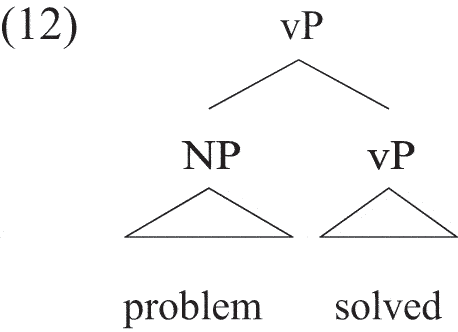
There is then no ellipsis in such structures, but rather a “reduced” syntactic structure compared to “normal” sentential structures.
Most of the data Progovac considers are predicate-argument structures: they can therefore receive propositional interpretations without the need for any special mechanism to retrieve any “missing” argument or predicate. They are therefore crucially different from Stainton’s and Merchant’s data, which consist of bare predicates or bare arguments (DPs).Footnote2 Some mechanism is therefore needed for these subsententials to “enhance” their interpretation to that of a proposition. It is the nature of that mechanism that will be discussed in the remainder of this article, though I will eventually argue for a solution which resembles Progovac’s, insofar as the propositional interpretation (for DP fragments) will be provided by a “small” amount of syntactic structure – not as much as a full clause, but more than is apparent on the surface.
2.2 Problems for previous approaches
The views on the resolution of antecedentless fragments, summarized above, can then be separated into two main camps as below:
(13) Nonelliptical views
a. Function application in Mentalese (Stainton passim)
b. “Slot-filling”/assignment of values to free variables (Merchant Citation2010)
(14) Elliptical views
a. “Limited ellipsis” (of e.g. it is) (Merchant Citation2004, see also e.g. Merchant Citation1998; Almeida and Yoshida Citation2007; Rodrigues, Nevins, and Vicente Citation2009; van Craenenbroeck Citation2010 a.o. on underlying cleft/copular sources for clausal ellipsis)
b. A “script,” i.e., the availability of a “conventionalized” linguistic antecedent for ellipsis (Merchant Citation2004, Citation2010)
As already noted above, the two approaches in (13) come very close to each other (by design on Merchant’s part, see Merchant Citation2010, sec. 7); there are distinctions to be drawn between the two in terms of approaches to the philosophy of language and the kind of power that can be granted to the variable assignment function, but in what follows I will conflate these approaches.
The question then arises of how many of these possibilities are actually available. Merchant (Citation2010) argues that they all are, in order to cover the variety of data points discussed above. This might be correct, and in particular, I think it is difficult to exclude the existence of the “limited ellipsis” (14a) strategy (at least in English) in light of the fact that pronoun and copula elision in initial position appears to otherwise be available. But I want to comment, firstly on some potential issues with the “script” proposal, and then on some data that seem to me to pose problems for all of the approaches listed above.
Merchant (Citation2004, Citation2010) evokes the notion of a script for cases such as (15).
(15) a. [In a taxi.] To the train station.
b. [In a café.] A coffee.
Merchant (Citation2010) argues that such fragments – especially ones like (15a) – can only receive the interpretations that they do in very particular contexts. He gives the example of someone standing in the middle of a town square and shouting (15a); he points out that it would be very difficult to interpret this as “I want to go to the train station” or “Take me to the train station.” By contrast, Merchant argues, such a fragment is immediately interpretable in a taxi, because the “script” of a taxi situation provides a (linguistic) antecedent equivalent to “take me to x” or “I want to go to x.”
This view of how these fragments are resolved requires the “script” of a situation to provide not just conventional expectations of “how things proceed” (which could be the basis for a nonsententialist “pragmatic” resolution of the ellipsis), but also sufficiently conventional linguistic expectations to provide the antecedent to resolve the ellipsis. The “man in the town square” scenario arguably provides neither of these, while the “taxi driver” or “café” scenarios arguably provide both; that is, conversations like the below are arguably “codified” enough that speakers have access to linguistic scripts for them in the relevant scenarios.
(16) a. Taxi driver: Where are you going?
Passenger: I’m going to the train station.
b. Barista: What can I get you? (or What would you like?)
Customer: I would like a coffee, please.
But there are situations where fragments can be felicitously used, where the intuition that a linguistic script is available is less clear. Suppose I am in Joe’s Bar with friends and want to propose we move on. I can utter (17).
(17) Right: to the next bar.
Situations like this one presumably provide a “script” in the sense of conventionalized expectations – in particular, that one way of enjoying an evening is to move from bar to bar – which on its own provides sufficient contextual information to understand why this fragment can be interpreted as “We should go to the next bar” or “Let’s go to the next bar.” But it is less clear that such “barhopping situations” provide a linguistic script – at least not in the same codified way as the conversations in (16), such that the linguistic antecedent We should go or Let’s go should be saliently available to resolve the fragment. Possibly such a script is present also for situations like (17), but this seems less likely for the following example from Shakespeare (originally discussed by Weir Citation2014, 128):
(18) A horse! A horse! My kingdom for a horse! (Richard III, act V scene IV)
It is clear that Richard III’s utterance A horse! can be understood as a request for a horse. To this extent, it seems parallel to A coffee in a café. Again, context is clearly assisting in the interpretation of this fragment: but it seems very unlikely that the interpretation is being derived from a “script” which provides “I want x.” The relevant situation – a king who has lost his horse on the battlefield – does not clearly provide any sort of “script” even in the sense of conventionalized expectations about how such situations proceed; it is certainly not as conventionalized as getting into a taxi or approaching the bar in a café, for example. A fortiori, it is difficult to imagine how this situation could provide a linguistic script from which the words I want could provide the antecedent for ellipsis. Some other mechanism then seems to be warranted for the interpretation of A horse!; but once we work out what that mechanism is, it seems reasonable to extend it to To the train station and A coffee as well.Footnote3
What is that other mechanism? A nonelliptical mechanism along the lines of (13) – where the fragment is a truly base-generated nonsentential in which any open variables are provided by context (or provides the argument to a contextually salient property) – seems like the most promising avenue initially. However, I argue that this view runs into certain empirical problems of its own. Consider again the second part of Richard III’s utterance, in (19a), and a more pedestrian café example in (19b).
(19) a. My kingdom for a horse!
b. A coffee for me, please.
Intuitively, the subsentential fragment in (19a) is interpreted as something like “I would give/trade/swap my kingdom for a horse” and the fragment in (19b) as something like “I would like a coffee.”Footnote4 On a base-generated/nonsentential view, what is the syntax – and semantics – of these examples? Such fragments appear to involve two main constituents, a DP and a PP, neither of which appears to be a subconstituent of the other. In particular, the PPs are not NP-internal. This is not immediately clear for (19b) but is semantically clear for (19a); here the PP for a horse does not semantically modify kingdom (it clearly does not refer to a “kingdom for a horse” that Richard III possesses).
If the PPs are not internal to the NPs in (18) – and if we are not assuming any syntactic structure beyond what is apparent on the surface – then something like the below syntax would have to be assumed:

What is “?” here? It could be an extended projection of PP, with my kingdom and a coffee respectively as specifiers. This would be equivalent to Progovac (Citation2006)’s analysis of similar “small” structures; it would in effect be a kind of small clause. For could have the semantic role of relating two entities: in (20a) it would relate a traded item to the item traded for, and in (20b), it would relate a possessum to a beneficiary/possessee. I illustrate a (very rough) possible semantics for (20b)’s for below (somewhat after Pylkkänen (Citation2008)’s semantics for benefactives):
(21) a. [[for]] = λx.λy.λe.forBenefit(x)(y)(e)
b. [[a coffee for me]] = λe.∃x.coffee(x) & forBenefit(speaker)(x)(e)
On such an analysis, such “double” fragments would already be propositional, and would not require any further “augmentation.”Footnote5 The for-phrases, although they look like adjuncts, would in fact be predicates, with the DP as their external argument.
It is possible that this is the correct analysis of these particular cases, but I do not think that it generalizes to all cases of antecedentless fragments containing both a DP and a modifier. Consider for example the below (out-of-the-blue, in a café):
(22) A coffee (with/using) that new machine you have, please.
(Using seems more natural than with in this case, but to my ear both are acceptable.) Here, using that new machine you have is clearly a “verbal”/event-modifying adjunct, not an adnominal one (i.e., it is not modifying the NP coffee): (23b) is unacceptable to mean that the coffee in question was made using the new machine.Footnote6
(23) a. I [made [a coffee] [using the new machine]].
b. *I [drank [a coffee using the new machine]].
But here using the new machine is not being predicated of a coffee either; i.e., a coffee cannot be interpreted as the external argument of using. So a small clause/predicative analysis of (22) does not seem open to us. Rather, using that new machine you have is truly an event-modifying adjunct: it is the making of a coffee in (22) that is being described as “using that new machine.” Further evidence for the genuine adjunct (rather than predicate) status of these modifiers comes from the fact that they can be iterated, and their orders modified (24abc); it is also possible to add time adjuncts like now, which again can only modify events, as in (24d).
(24) a. A coffee for me using the new machine, please.
b. A coffee using the new machine for me, please.
c. For me a coffee, please.
d. A coffee now, please.
What, then, is the syntax of these cases, if not PP small clauses? The only other possibility, on a completely “surfacist”/“what you see is what you get” view, appears to be to adjoin the adjuncts to DP:
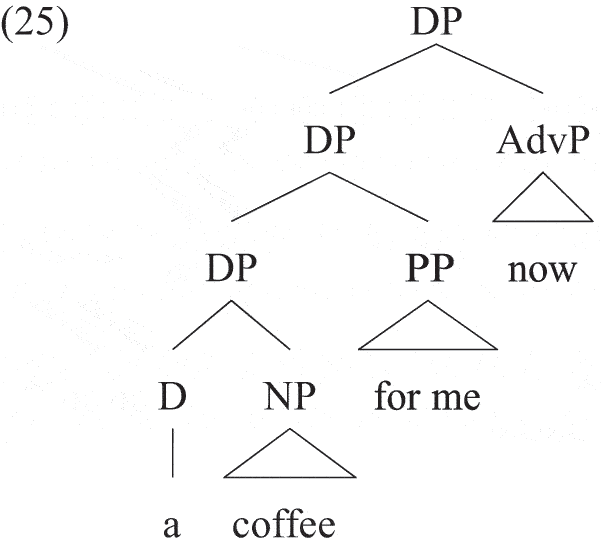
But this also seems implausible, for two reasons. The first is that it is not otherwise clear that PPs can syntactically adjoin to (full) DPs in this way in English, and it is certainly not possible to adjoin such PPs to the left of a DP, as (24c) would require:
(26) a. I will brief you on [the situation at that time].
b. *I will brief you on [at that time the situation].
The semantics would also not be correct. Time adverbials like now modify events, and DPs like a coffee do not, on standard assumptions, provide an event argument to modify.Footnote7
So, the “fully” nonsententialist approach does not seem promising for the analysis of fragments like A coffee for me. Do we then need to have recourse to sententialism and say that (27a) is truly underlyingly elliptical for the sentential source in (27b), and similarly for (28)?
(27) a. A coffee for me (using the new machine) (now), please.
b. Make a coffee for me (using the new machine) (now), please.
(28) a. My kingdom for a horse!
b. I will trade my kingdom for a horse!
To allow this (and given that I reject the notion of “script” for a case like (28)), we would have to bite the bullet and say that truly linguistic material can be “accommodated” from context, even if there is no overt antecedent (as I propose in Weir Citation2014, 133ff.). The verbs make/trade, if they were underlyingly present in the syntax, would provide the necessary event argument for the adjuncts to modify, and the syntactic structure for the adjuncts to be adjoined to. However, this approach too has problems. In particular, (29) is highly degraded in an out-of-the-blue café context.
(29) a. *Me a coffee.
b. *My friend a coffee.
This is true even though A coffee for me/my friend is grammatical, and so is the putative sentential source (30):
(30) Make me/my friend a coffee.
If the underlying source for antecedentless fragments is sentential, why would a beneficiary argument of make be expressible in a for-PP, but not as an indirect object (29)? Note that there is nothing inherently ungrammatical about (29) as remnants of ellipsis as such. Such expressions can function as fragment answers to overt questions, for example. (31) is admittedly somewhat marginal, but to my ear considerably better than (29) in a way that is not obviously explicable if (29) is elliptical. (32), an example of gapping, is clearly acceptable; importantly, (29) does not improve even in a conjunction (which might increase the acceptability of gapping, i.e., having two separate remnants of ellipsis), (33).
(31) A: What should I make?/Who should I make what?
B: ?My friend a coffee.
(32) a. The barista made me a latte and my friend a tea.
b. A: Who should I make what?
B: Me a latte and my friend a tea.
(33) [out of the blue at a café]
*Me a latte and my friend a tea.
This contrast suggests that ellipsis of truly linguistic material is not underlying these fragments: If make can be “accommodated” in make a coffee for me, it is difficult to see why it could not be similarly accommodated in (the ungrammatical) make me a coffee.
There are also DP + modifier fragments where it seems difficult to provide any underlying elliptical source at all. Consider (34), again out-of-the-blue at a café counter:
(34) [holding up a sandwich]
This sandwich for me, please.Footnote8
What verb could be underlying this? Not make or bring, as the sandwich does not need to be made or brought. Not sell or give, as these take to-PPs to indicate their beneficiaries, not for-PPs. Not take, given the marginality of ??I’ll take this sandwich for me, please. It is fact difficult to imagine any verb that could plausibly underlie (34). One possibility might be ring up (i.e., on the cash register). But ?Ring up this sandwich for me seems like an unlikely thing to say nonelliptically in this context. More problematically, (35a) is grammatical and more-or-less felicitous, but the putative elided version in (35b) is very strange (in an out-of-the-blue context).Footnote9
(35) a. Ring up this sandwich for me on the cash register.
b. ?#This sandwich for me on the cash register.
There appear then to be problems for both the nonelliptical view and the elliptical view of antecedentless fragment resolution. The elliptical view, as shown above, seems to both over- and undergenerate: overgenerate because it predicts the grammaticality of fragments like *Me a coffee, and undergenerate because it is not clear what the elliptical source of a fragment like This sandwich for me is. But the nonelliptical view appears to suffer from syntactic and semantic problems: verbal adjuncts (which modify events) seem to be attached to DPs, which both generally do not permit adjunction of this type, and do not (in general) provide the requisite event argument for the adjunct to modify.
In what follows, I propose a middle path between the elliptical and nonelliptical views. There is, in antecedentless (DP) fragments like a coffee, a small amount of syntactic structure beyond what is seen on the surface, which introduces an event argument and allows for adjunction. Crucially, though, this structure is not verbal in nature, and does not allow for functional projections which crucially rely on verbal structure being present: it is this which will rule out examples like *Me a coffee.
3 Subsentential structures and thematic roles
3.1 The approach in outline
The schematic outline of the solution is that antecedentless fragments like A coffee are DPs embedded within a small amount of functional structure, shown as XP below.
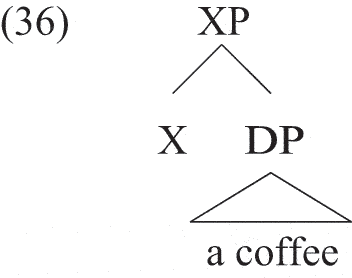
The DP a coffee is a generalized quantifier, as normal (37a). The role of X is to provide a thematic role which can provide the scope of such a quantifier, that is, introduce an event argument in the way shown in (37b, c).Footnote10 I assume that, in this case, the thematic role assigned is the extremely general role “theme.”Footnote11
(37) a. [[a coffee]] = λP.∃x.coffee(x) & P(x)
b. [[X]] = λQ<et, t>.λe.Q(λx.theme(x)(e))
c. [[X a coffee]] = λe.∃x.coffee(x) & theme(x)(e)
Once this amount of structure is introduced, there is no semantic barrier to modifying it with event modifiers adjoined to XP.
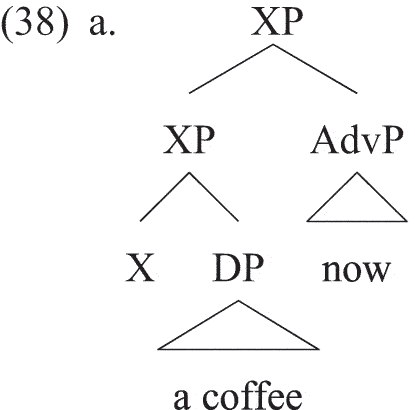
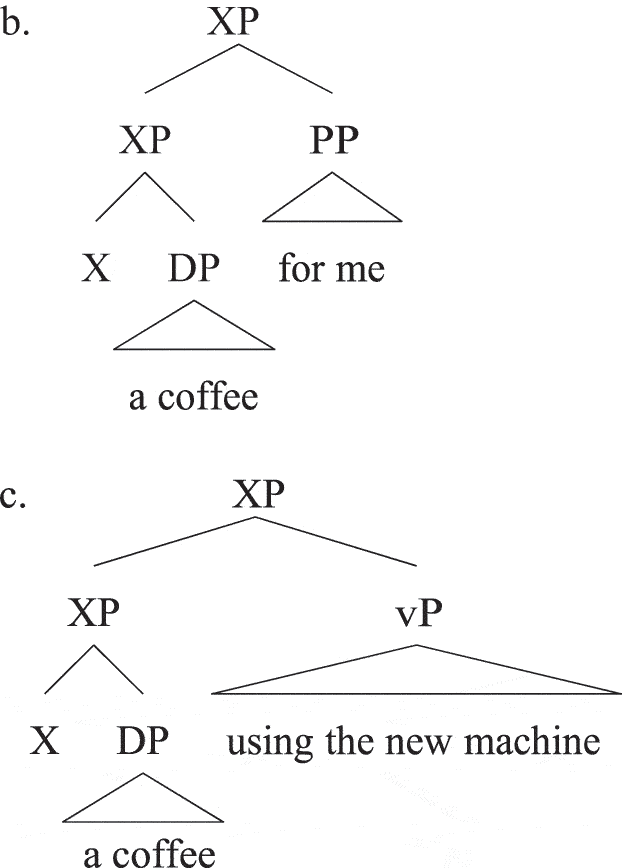
A sample semantic derivation for (38b) is given in (39); the others proceed analogously:
(39) a. [[for me]] = λe.beneficiary(spkr)(e)
b. [[[X a coffee] for me]] = λe.∃x.coffee(x) & theme(x)(e) & beneficiary(spkr)(e)
(via intersective modification with (37c))
The “Richard III” example can also be treated this way, assuming that for is polysemous and can also introduce a role like “price” (as in He swapped his kingdom for a horse, He sold the car for six hundred dollars).Footnote12 I abbreviate the translation of a horse as simply horse (rather than λP.∃x.horse(x) & P(x)) to avoid cluttering the translations.
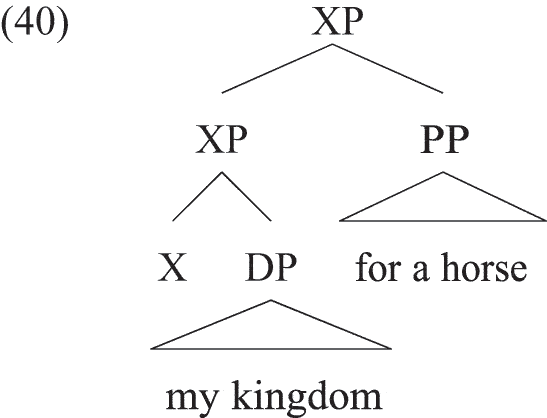
(41) a. [[for a horse]] = λe.price(horse)(e)
b. [[[X my kingdom] for a horse]] = λe.theme(kingdom)(e) & price(horse)(e)
Given event descriptions such as these, the event argument can be existentially closed (as is standardly assumed to be possible), resulting in a propositional meaning:
(42) Existential closure of (39b):
∃e.∃x.coffee(x) & theme(x)(e) & beneficiary(spkr)(e)
This propositional meaning is of course not quite the expected meaning for a coffee for me, which does not generally mean that there is an event of which coffee is the theme and the speaker is the beneficiary. In fact, the normal reading of a coffee for me is not truth-conditional/propositional (i.e., declarative-like, capable of being true or false) at all, but rather a request. Notably, though, similar antecedentless fragments (with event modifiers) do seem to be able to have such a declarative/propositional meaning given the right context, suggesting that it is right to suggest that such antecedentless fragments do have a propositional “core”:
(43) [Handing out parcels] This one for Jonny.
Somehow, (42) must be “augmented” to have the speech act meaning of a request or imperative: something akin to “Bring it about that there is an event of which coffee is the theme and I am the beneficiary.” I will not commit myself here to how this is done, and in particular will not commit myself to whether this is a “purely pragmatic” process or whether it has any reflex in the syntax or semantics “proper” (one could for example imagine inserting a covert modal in the structure above, either in the syntax or as a type-shift in the semantics), as I do not know how to tease these possibilities apart; but I will assume that whatever process allows an imperative like Everyone sit down! to be appropriately interpreted as a speech act (“Bring it about that … ”) is also available to cases like (42) (and see also Progovac Citation2006, 58ff. on the irrealis interpretation of tenseless structures).
The propositional core in (42) has a rather “light” underspecified meaning; it asserts (or requests, once the appropriate “augmentation” to a speech act has taken place) that there is an event whose theme is coffee and whose beneficiary is the speaker. But it does not specify in any more detail what kind of event that is; whether it is a making, or a bringing, or a selling. That seems to be a desirable result. Stainton (Citation2006b, 69) notes that this sort of underspecification seems to be a general property of (antecedentless) subsententials:
Sentences are precise in ways that what is asserted/commanded in sub-sentential speech frequently is not. Take ‘To Segovia’ [on getting into a taxi, AW]. If a sentence was intended, it must have been one of [(a–d)], or some other specific sentence:
a. Take me to Segovia
b. Drive me to Segovia
c. I want to go to Segovia
d. I’m going to Segovia
But there is no reason to pick exactly one of these, or to pick any other sentence […] all of them are patently incorrect descriptions of what [the speaker] meant. For each of them is too “contentful” – too precise in ways that he was not (Stainton Citation2006b, 69)
Moreover, we saw an example above (This sandwich for me, please, (34)) where it seems that a sentential paraphrase simply cannot be provided. All this utterance asserts(/requests) is that there is an event with the indicated sandwich as theme and the speaker as beneficiary: it is the context which makes clear that the relevant event is one of buying/selling the sandwich.
In this connection, recall the infelicitous example in (35b), repeated in (44):
(44) ?#This sandwich for me on the cash register.
On the proposed analysis, there is nothing in fact syntactically or semantically ill-formed about such an example: it has the syntax in (45a), and the semantics in (45b).
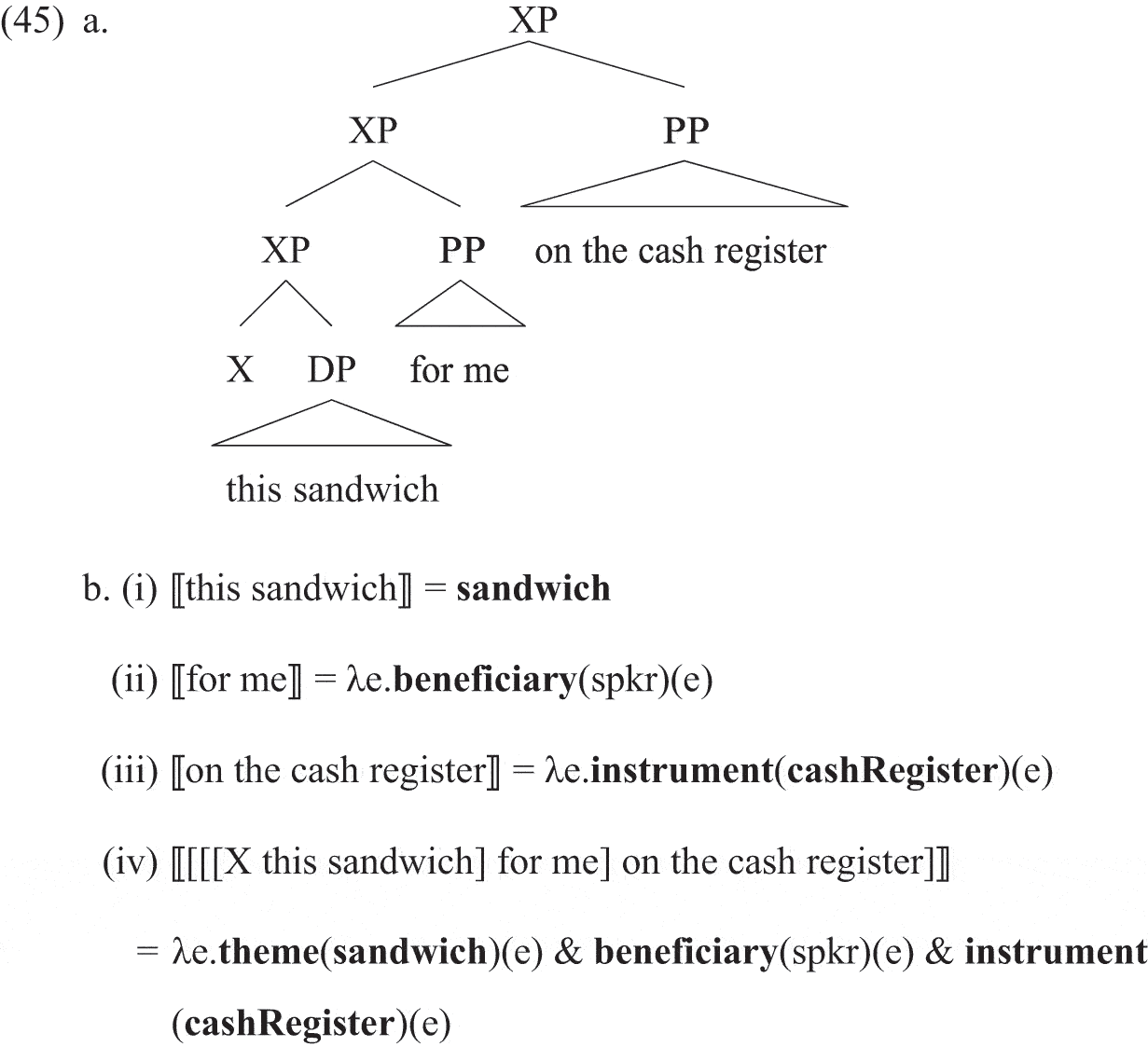
I think it is correct to say that (44) is not syntactically ill-formed (see footnote 9). I do not think that it is semantically ill-formed either: I think it does indeed result in the (well-formed as such) interpretation shown in (45b, iv). I think that the infelicity of this example has a pragmatic source. The intuition is that one should not get too specific with the event description that a subsentential denotes; that, in a sense, the “point” of using subsententials is precisely to remain vague about the nature of the event under discussion. (Is the interaction that takes place at a coffee counter a buying, a selling, a bringing (of coffee), a making (of coffee) – or all of these and more? All of these events are encompassed by “λe.∃x.coffee(x) & theme(x)(e) & beneficiary(spkr)(e)”.) Once one introduces the instrumental modifier on the cash register, one is referring to a kind of event that must be very specific; it can only refer to the “ringing-up” event (not the “surrounding” parts of the interaction; the making of the coffee, the bringing of it, etc.). That is, of course, just a slightly odd event to make specific reference to in the context in the first place; but, given that there does exist a verb ring up to describe exactly such events, one might also imagine that there is a pragmatic pressure to use that verb if a speaker does happen to want to make reference to such an event. That is, if the semantics of subsententials provides a very underspecified description of an event, then there is perhaps a pragmatic pressure in favor of using subsententials in cases where the language does not make (overt, object-language) predicates of sufficient generality available, and a pragmatic clash if a subsentential is made too specific.
3.2 What is X?
What, then, is the identity of the head X? If the analysis given above is on the right track, then X appears to take a (nominal) complement and assign a thematic role to it (introducing an event variable into the semantic representation). In addition to this, it has been noted (Merchant Citation2004, 730, Citation2010, fn. 11) that in languages with theta-related/clearly “semantic” case, antecedentless fragments can, and in fact must, show such case marking. For example, the Russian equivalent of the antecedentless fragment Both hands! in (46) – meaning something like “Use both hands!” – must appear in instrumental case (46a), not in nominative/citation form (46b).Footnote13
(46) [Russian: to a child carrying soup unsteadily; Merchant 2010, fn. 11]
a. Dvumja rukami!
two:INS hands:INS
‘Both hands!’
b. #Dve ruki!
two.NOM hand:GEN
We can hypothesize, then that X is a Case assigner in addition to a theta-role assigner. There are, then, two candidates which are most plausible for its category: V or P.Footnote14 In both cases, the V or P in question would have to be empty/unpronounced. It is not clear whether we want to admit a null (lexical) V into English, at least not without placing heavy restrictions on where it can occur.Footnote15 Without some additional stipulation, we would risk generating fully sentential structures with a null V (assigning the “theme” role), which do not seem to occur, either in a putative transitive variant as in (47) or an unaccusative variant as in (48).
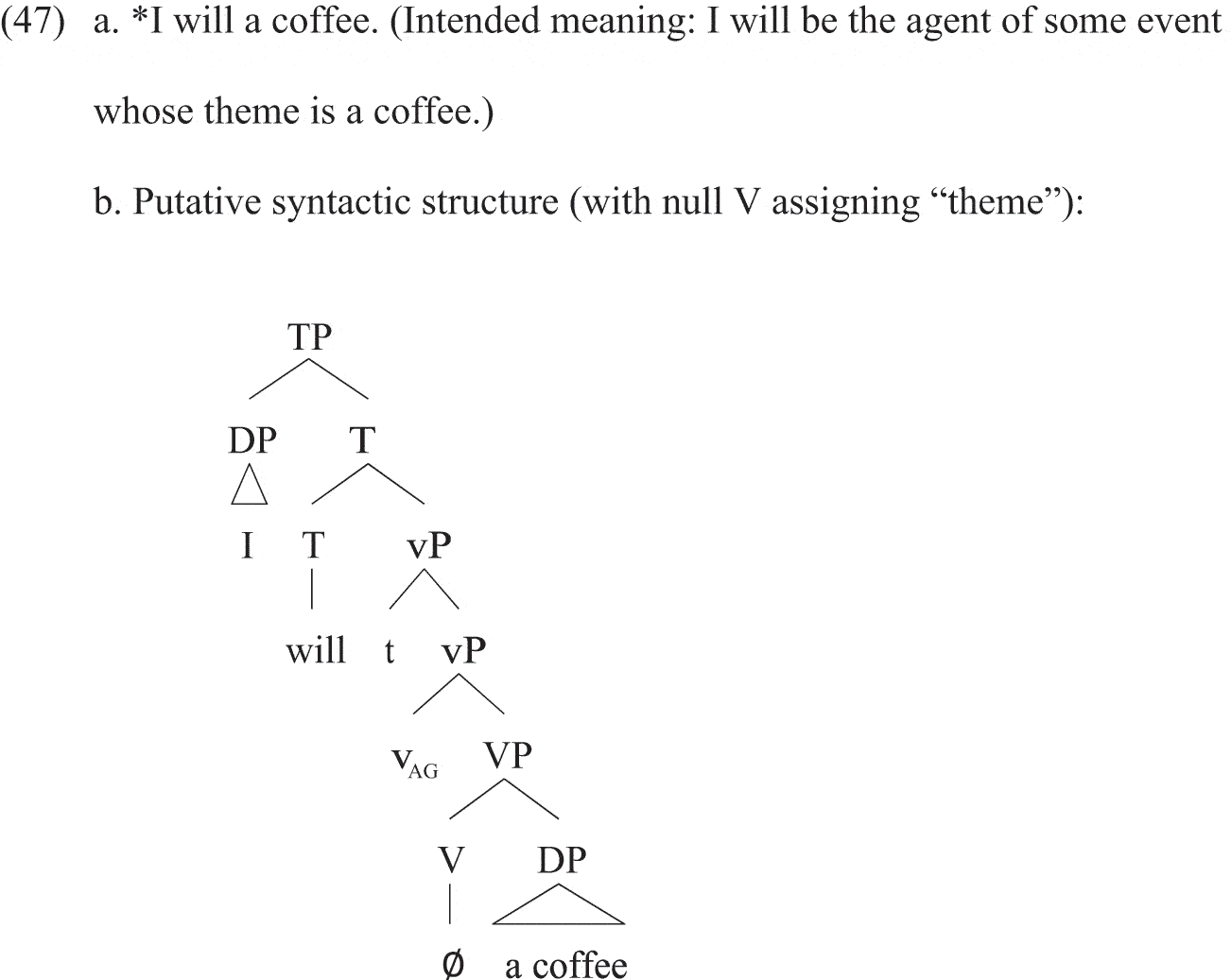
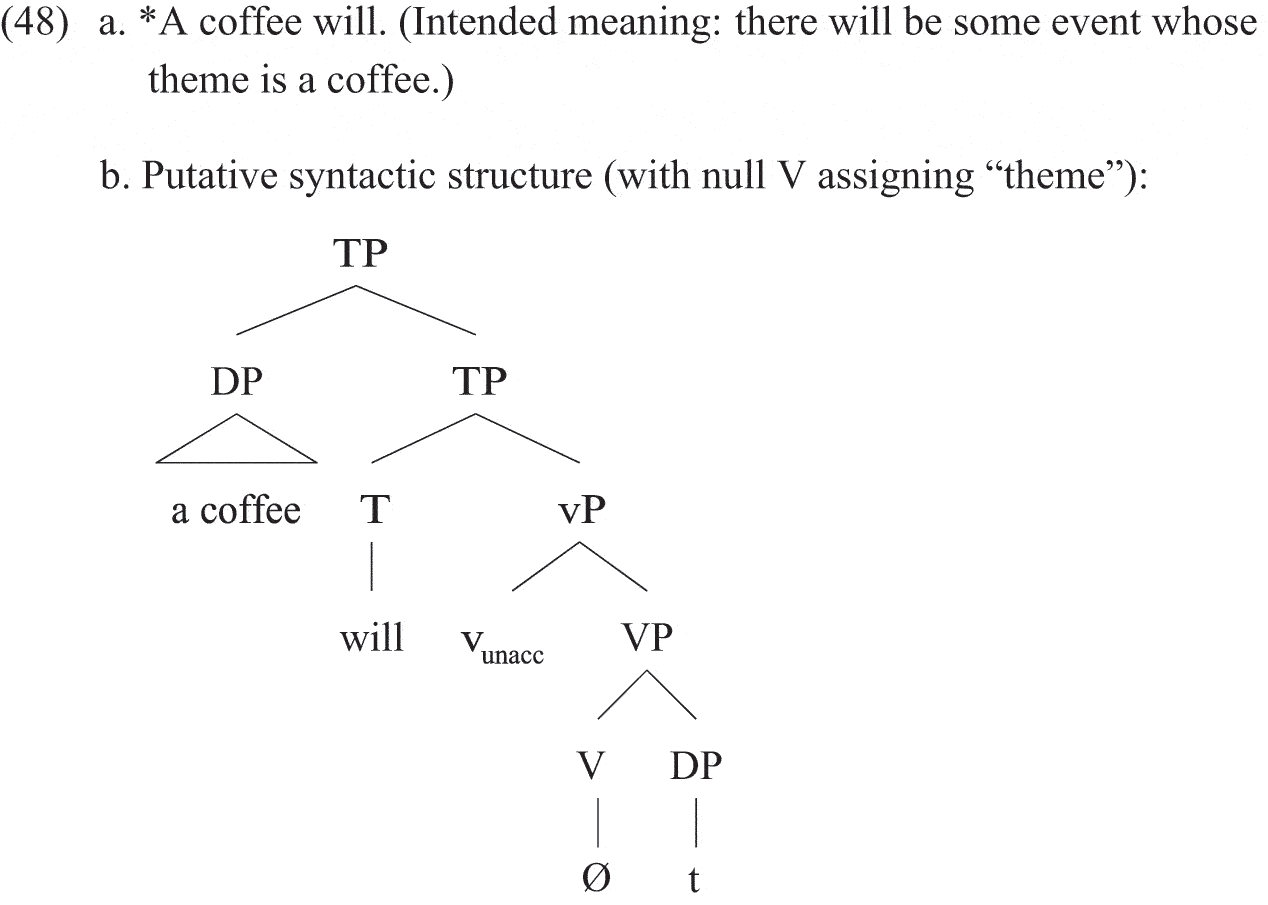
There is, however, a line of work which proposes that DPs bearing theta-related case are actually PPs, headed by a null P; see Emonds (Citation1987), and Režać (Citation2008) defends this proposal on independent grounds concerning the (in)visibility to Agree of DPs bearing theta-related case. This would integrate well with the current proposal: such a null P could introduce an event argument and assign the “instrument” thematic role to its complement.
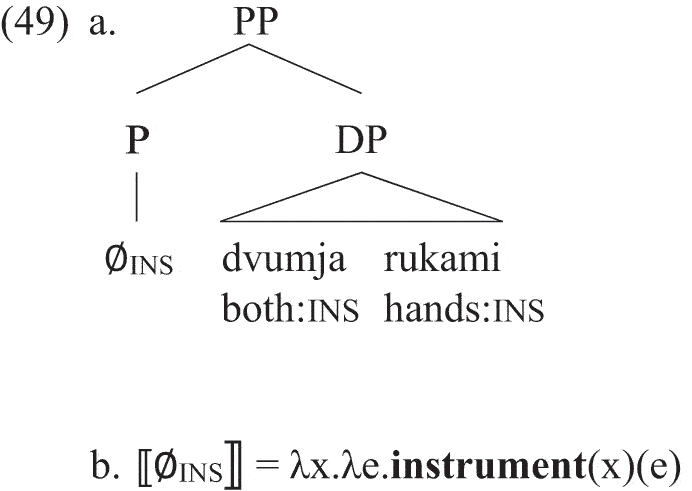
If such null Ps assigning theta roles are a general possibility, then it may not be implausible that there is a Theme-assigning null P in English (which assigns accusative to its complement), of the type hypothesized for X above.
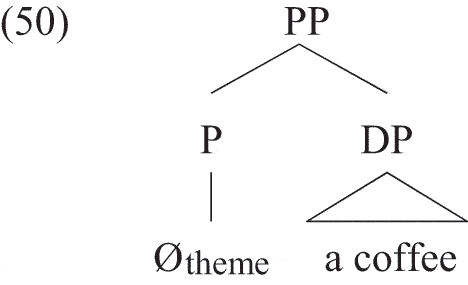
Note that on such a view, we can in fact assume a “fully WYSIWYG” analysis for PP antecedentless fragments like to the train station.
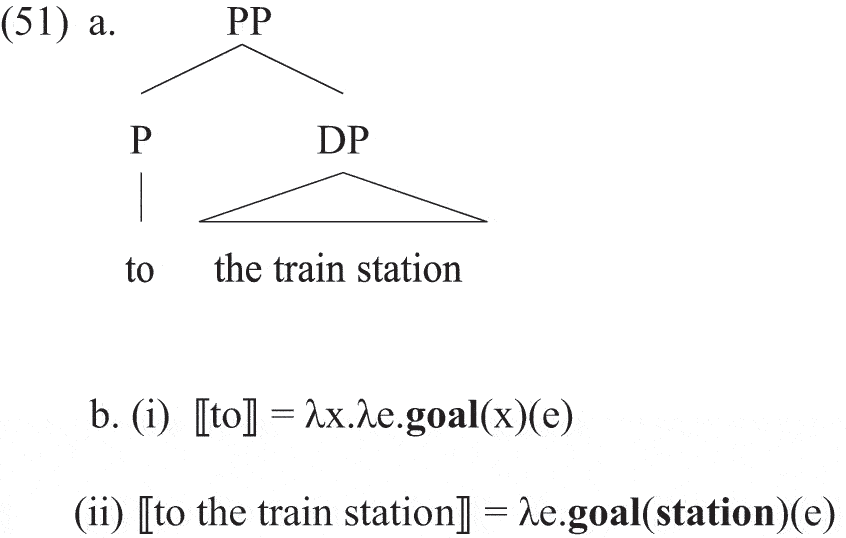
Given that I rejected the idea of a null V above on the basis that it did not seem to be otherwise available in English, we might reasonably ask if a theme-introducing null P is available outside of antecedentless structures.Footnote16 I tentatively propose that such a P could be responsible for the introduction of a Theme argument in optional transitive verbs, such as eat:
(52) a. John ate.
b. John ate the cake.
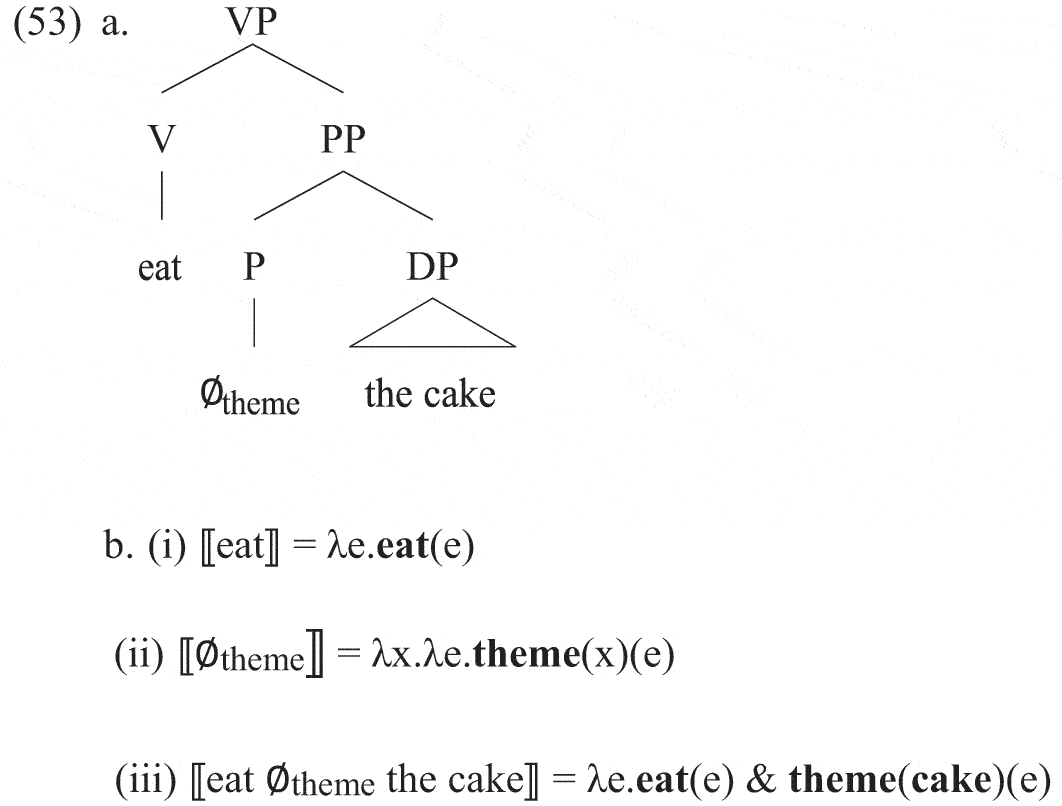
See Kratzer (Citation2002) for arguments that verbs like eat are underlyingly intransitive (that is, they have denotations like that in (53b, i), and are not “detransitivized” by a rule of unspecified object deletion as in Dowty (Citation1978)), and so must have their object arguments “built up” in the syntax. Whether this is done via a null P head in the way sketched above (as opposed to, say, in the specifier position of a v head) seems difficult to empirically test, and it is beyond the scope of this article to try to fully defend this position here; but there does not seem to be anything ruling out structures like (53) a priori, if we accept the availability of null Ps in general.Footnote17
3.3 Advantages of not assuming verbal structure
Assuming that P but not V is implicated in antecedentless fragments also helps us understand why (54a) is grammatical but (54b) sharply is not, even though one might think the indirect object me in (54b) could be assigned the “beneficiary” thematic role just as it is in make me a coffee.
(54) a. A coffee for me.
b. *Me a coffee.
I assume that for me, as PP adjunct, is freely adjoinable in the way shown in the trees above. Indirect objects like me in (54b), however, are much more restricted. As is standard, I assume that such indirect objects (in the normal sentential case) are introduced in the specifier position of a functional projection above the verb, here called ApplP, with subsequent movement of the verb through Appl to the v head which introduces the external argument:
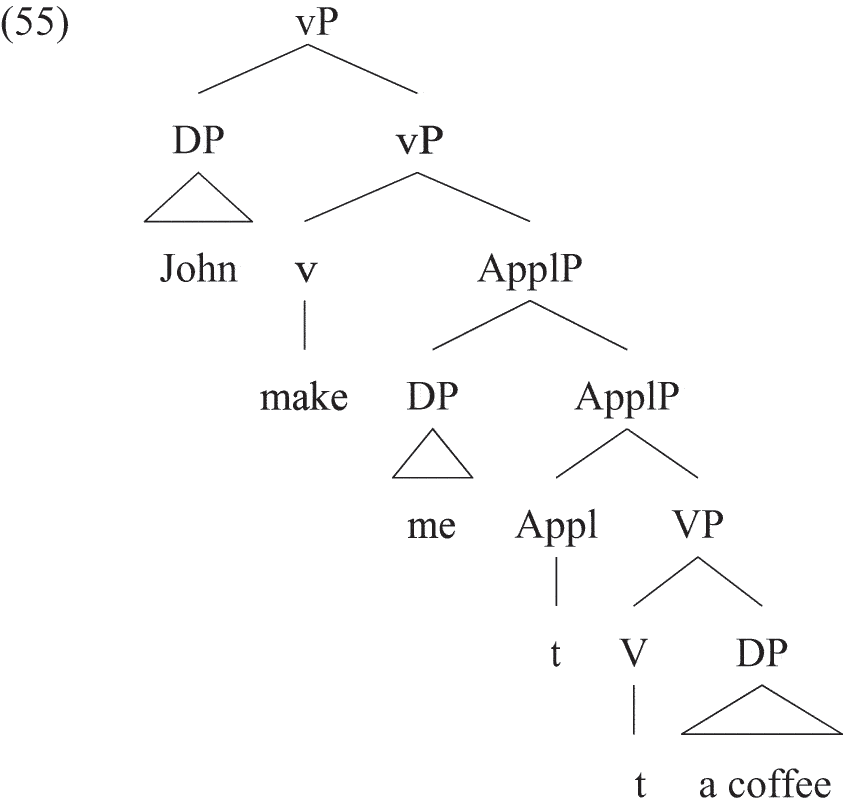
If the introduction of a beneficiary indirect object is crucially dependent on ApplP – and if Appl itself selects for a VP – then it is predicted that indirect objects should not be able to co-occur with theme arguments in antecedentless fragments, as these contain no VP.
Consider also the below data:
(56) [John and Mary are taking a cookery class. The chef gives instruction:]
a. The apple pie at 200 degrees (and the cherry pie at 180 degrees).
b. ??John at 200 degrees (and Mary at 180 degrees).
c. ??John the apple pie (and Mary the cherry pie).
It is very easy in context to understand (56a) as meaning “Bake the apple pie at 200 degrees,” even without a linguistic antecedent. It is by contrast much harder to understand (56b) as meaning that John should bake something at 200 degrees.Footnote18 And while the intended reading of (56c) is clear (i.e., that John should bake the apple pie and Mary the cherry pie), the string is nevertheless degraded out-of-the-blue, although it would be grammatical if it had an overt antecedent like Who should bake what?.
This is, I argue, expected on the present analysis. John and Mary in (56b, c) are intended as agents; and agents are generally held to be syntactically introduced by a “little v” head or by Voice (Kratzer Citation1996).
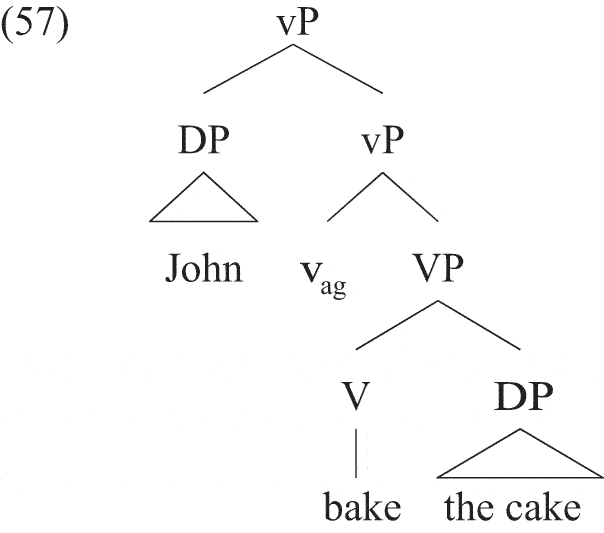
Such a functional projection would again be dependent on the presence of verbal structure (i.e., vag selects for (some extended projection of) VP). If there is no verbal structure present in antecedentless fragments, there is no way of introducing an agent in cases like (56b, c). Cases like (56a) are possible because the adjunct at 200 degrees can adjoin to the PP introducing the theme the apple pie:
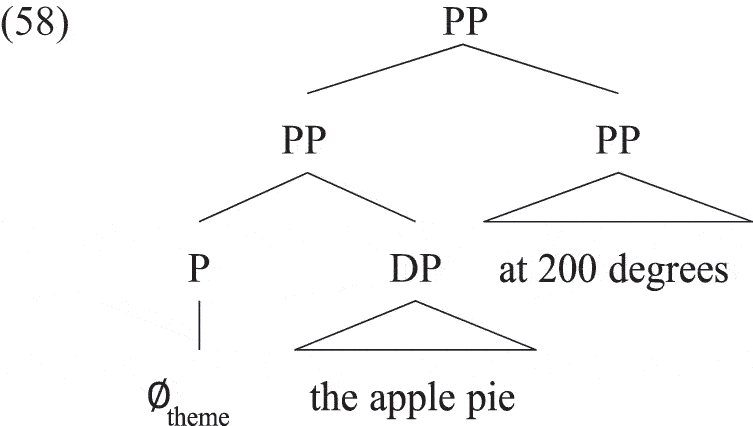
It is of course possible to use an antecedentless fragment to express (what looks like) an agent, as in the below case (from Weir Citation2014, 153):
(59) [A comes in and discovers that on the kitchen table, where there should be a beautiful roast leg of lamb, there is only a greasy plate. A looks at B and raises his eyebrows. B explains:]
The dog.
However, the present analysis does not exclude the possibility that “limited ellipsis” is also open to the grammar. That is, the structure of (59) might underlyingly be (60), which has the right meaning:
(60) It was the dog.
As noted in section 2.1, it is in fact difficult to rule out the possibility of such “left-edge” ellipsis. Some support for this comes from the fact that tag questions can be used with such fragments, but only with it, not with a pronoun that refers to the putative subject (see also Barros and van Craenenbroeck Citation2013):
(61) [Same context as (59), but A asks B:]
The dog, was it?/??did he?
We can also note the following asymmetry (discussed by Weir Citation2014, 153, but given a different analysis):
(62) [Same context as (59)]
a. The dog.
b. ??By the dog.
This asymmetry is somewhat mysterious on the sententialist perspective, as both the putative sentential sources in (63) are felicitous in the context and should be available.
(63) a. The dog ate it.
b. It was eaten by the dog.
It is, however, explicable on a nonsententialist perspective (either the one presented here, or one like Stainton’s). As Jaeggli (Citation1986) notes, the by-phrase in a passive does not assign a consistent theta-role; rather, it depends on the theta-role assigned to the external argument of the passivized verb.
(64) (Jaeggli Citation1986, 599)
a. Bill was killed by Mary. (Agent)
b. The letter was received by Bill. (Goal)
c. That professor is feared by all students. (Experiencer)
And, as Jaeggli also notes, by-phrases of this sort are also syntactically dependent on the presence of a passive verb. They cannot be used with inchoatives to introduce an agent or causer, for example (65).
(65) *The ice melted by John/by the sun.
Passive by-phrases are then both semantically and syntactically dependent on the presence of a (passive) verb. How to encode this behavior of passive by-phrases is not crucial here; the crucial point is that a nonsententialist analysis of antecedentless fragments does not then need to say anything more to capture the degraded nature of (62b). In such analyses, there is no verb, and so no way for the by-phrase in (62b) to be licensed.
4 Conclusion
I have argued that antecedentless fragments – at least those which are not amenable to strategies of “limited ellipsis” such as deletion of it is – contain “just enough” syntactic structure to be semantically interpreted as event descriptions. PP fragments like To the train station are truly WYSIWYG, while DP fragments rely on the presence of a covert theta-role assigning head – crucially not a verbal head – which projects a phrase which event modifiers can adjoin to and semantically modify.
I close by making a brief comment on the implications for fragments and theories of (clausal) ellipsis more generally. Once one accepts a nonsententialist analysis for antecedentless fragments, one might wonder whether it can be extended to cases of fragments in general, including those which do have antecedents, like (66).
(66) A: What would you like?
B: A coffee.
I am not immediately sure that it should be; Merchant (Citation2004) lists a number of properties of such fragments which suggest that there genuinely is underlying syntactic structure, i.e., that (66) really is elliptical for I would like a coffee. And as I have noted throughout, many cases of gapping-like structures which are ungrammatical without a linguistic antecedent become grammatical if there is such an antecedent – suggesting that there does exist a process of ellipsis which is sensitive to the truly linguistic context, and which has different properties to the analysis proposed here for antecedentless fragments.
But the acceptance of a nonsententialist analysis for antecedentless fragments may have ramifications for analyses of clausal ellipsis which does involve an antecedent, and in particular how the relevant condition of “identity” between antecedent and ellipsis site is understood. Some accounts of cases like (66) (e.g., Weir Citation2014) propose that clausal ellipsis can proceed under identity with a (formally specified) discourse-pragmatic object, specifically the Question under Discussion – precisely so that the (elliptical, sententialist) account of cases like (66) could also encompass antecedentless fragments (i.e., there need not be a syntactic/linguistic antecedent for ellipsis, as long as there is a (possibly implicit) discourse antecedent). If antecedentless fragments are not derived by clausal ellipsis, however, then it is less clear that the identity relation in ellipsis needs to refer to a semantic/pragmatic antecedent, as opposed to a syntactic/structural one (a condition which seems to be required in any event; see, e.g., Merchant Citation2013). There may still be reasons to favor a QUD-based/pragmatic identity condition for clausal ellipsis instead of (or alongside) a syntactic one (see, e.g., AnderBois Citation2014), but if the proposal in this paper is on the right track, one argument for a pragmatic identity condition in clausal ellipsis may be weakened. It may indeed even be the case that cases like (66) really do not involve ellipsis and genuinely are generated in the “near-WYSIWYG” fashion outlined in this paper; but investigating that fully is a task that has to be left to future work.
Acknowledgments
I would like to thank the Editors of this special issue for the invitation to submit this paper, as well as two anonymous reviewers for Acta Linguistica Hafniensia for their comments. Any errors of course remain my own.
Disclosure statement
No potential conflict of interest was reported by the author.
Additional information
Notes on contributors
Andrew Weir
Andrew Weir is associate professor of English linguistics at NTNU Norwegian University of Science and Technology, Trondheim, where he is a member of the Acquisition, Variation and Attrition (AcqVA) research group. He specializes in generative syntax and semantics with a particular focus on ellipsis, (micro)comparative syntax, and register and dialect variation.
Notes
1 An expression of the form “λx.F(x)” represents a function F which combines with a single argument x to yield a proposition. In this article, I use x, y as variables over entities, e as a variable over events, P as a variable over properties (i.e., one-place predicates), and Q as a variable over generalized quantifiers (i.e., functions from properties to propositions). Bold text indicates constants (predicates or entities).
2 Progovac does consider bare predicates and bare arguments (Citation2006, 56f), but does not focus on their analysis, assuming that they are handled by some means similar to either Stainton’s or Merchant’s proposals.
3 This is not to say that there are no potentially conventionalized cases of fragments. Merchant (Citation2004, Citation2010) discusses, e.g., the case of answering the phone in Dutch by saying Met X “with X” (=“You’re speaking with X”). But such cases really do seem to be circumscribed to a relatively small number of conventionalized scenarios, in contrast with, e.g., To the next bar or A horse!.
4 Note that I do not try to give a paraphrase for (19b) which tries to integrate it into a sentential surface syntax, e.g., Make a coffee for me, please, because as I discuss below, I do not think that is what is going on in examples like (19b).
5 Something more would need to be said to ensure that the meaning was correctly interpreted as “Make me a coffee” rather than, say, “I have a coffee.” See more on this in section 3.1 below.
6 A different, VP-modifying bracketing for (23b) is of course available, meaning that the drinking happened by means of the new machine.
7 Of course, some nouns (like situation in (26)) can be modified by temporal modifiers and so arguably do provide event arguments, and perhaps nouns like coffee also allow this on a particular reading:
(i) [The coffee now] is better than [the coffee we used to get].
But this is still a “noun-modifying” interpretation; (i) refers to the coffee that exists now rather than the coffee that used to exist. By contrast, in (24d), now is clearly having the effect of modifying the event: it is the making (or bringing or selling) of the coffee that should happen “now.”
8 Note that this example also makes clear that for me cannot be adjoined to the NP sandwich, as the demonstrative this is clearly only taking sandwich as complement (the demonstrative picks out the indicated sandwich as opposed to others, not something which is a “sandwich for me.”)
9 Note that (35b) is (in my judgement) not ungrammatical as such, but rather infelicitous or semantically deviant in this context. (It contrasts with (29) in this respect, where I feel a much stronger intuition of genuine syntactic ungrammaticality.) This intuition will be returned to in section 3.1.
10 Note that I assume here that X semantically combines directly with a generalized quantifier. This is mostly for the sake of exposition, but also because I am not sure what tests could diagnose the presence or absence of quantifier raising in these constructions (i.e., a structure where X combines with an argument of type e, and quantifier phrases raise in the normal way to ensure there is not a type mismatch). I therefore remain agnostic on the matter here.
11 Pace argumentation in Kratzer (Citation2002) that there is no such very general role. I think nothing would be lost by substituting another designation such as “affected patient” or “effected patient.”
12 Again, whether “price” is the precisely correct label for this role is less important than just the fact that for-adjuncts can introduce arguments of this type.
13 The genitive case on ruki in (46b) is prompted by the numeral dve “two.”
14 A reviewer asks if X could rather be an eventive noun, which would also introduce an event variable and allow for the assignment of a theta-role. But, as far as I can see, to accommodate noun phrase fragments like A coffee, treating X itself as a noun would require a noun to take a noun phrase as immediate complement, which at least in English is not possible (the destruction *(of) the city).
15 In general, when null lexical Vs have been proposed, it has been argued that they have to be formally licensed in some way (e.g., null motion verbs in Germanic being dependent on the presence of (an appropriate kind of) auxiliary verb or modal element, van Riemsdijk Citation2002 a.o.).
16 Null prepositions are frequently proposed in various other domains in English, as in analyses of he is home or he went there as he is AT home/he went TO there (Emonds Citation1976; Bresnan and Grimshaw Citation1978; McCawley Citation1988; Collins Citation2007; see also Kayne Citation2005, ch. 4). A question I leave aside here is whether null Ps require the kind of formal licensing discussed in footnote 15 for null Vs (as assumed by, e.g., den Dikken Citation2010; Myler Citation2013). I have to assume that at least the null theme-assigning P I propose here for English does not require licensing – possibly because it is lexically “specified” for silence and is not the “silencing” of an element which is otherwise pronounced.
17 The complement of such Ps would have to be a possible target of A-movement, to allow for passives like The cake was eaten. But pseudopassives like We were lied to show that this is a general possibility.
18 It much more easily gets the gruesome – and much less plausible in context – reading where John and Mary are the themes of the baking – which is the only expected reading on the current analysis.
References
- Almeida, Diogo A. de A., and Masaya Yoshida. 2007. “A Problem for the Preposition Stranding Generalization.” Linguistic Inquiry 38 (2): 349–362. doi:10.1162/ling.2007.38.2.349.
- AnderBois, Scott. 2014. “The Semantics of Sluicing: Beyond Truth Conditions.” Language 90 (4): 887–926. doi:10.1353/lan.2014.0110.
- Barros, Matthew, and Jeroen van Craenenbroeck. 2013. “Tag Questions and Ellipsis.” DGfS Handout. Accessed 27 August 2018. http://www.crissp.be/wp-content/uploads/2012/03/handout_dgfs_tags.pdf
- Bresnan, Joan, and Jane Grimshaw. 1978. “The Syntax of Free Relatives in English.” Linguistic Inquiry 9 (3): 331–391.
- Collins, Chris. 2007. “Home Sweet Home.” NYU Working Papers in Linguistics 1: 1–34.
- Culicover, Peter W., and Ray Jackendoff. 2005. Simpler Syntax. Oxford: Oxford University Press.
- den Dikken, Marcel. 2010. “Directions from the GET-GO: On the Syntax of Manner-of-motion Verbs in Directional Constructions.” Catalan Journal of Linguistics 9: 23–53.
- Dowty, David. 1978. “Governed Transformations as Lexical Rules in a Montague Grammar.” Linguistic Inquiry 9 (3): 393–426.
- Emonds, Joseph E. 1976. A Transformational Approach to English Syntax: Root, Structure-preserving and Local Transformations. New York: Academic Press.
- Emonds, Joseph E. 1987. “The Invisible Category Principle.” Linguistic Inquiry 18 (4): 613–632.
- Fitzpatrick, Justin M. 2006. “Deletion through Movement.” Natural Language & Linguistic Theory 24 (2): 399–431. doi:10.1007/s11049-005-3606-3.
- Ginzburg, Jonathan, and Ivan Sag. 2000. Interrogative Investigations. Stanford: CSLI Publications.
- Hankamer, Jorge, and Ivan Sag. 1976. “Deep and Surface Anaphora.” Linguistic Inquiry 7 (3): 391–426.
- Jacobson, Pauline. 2016. “The Short Answer: Implications for Direct Compositionality (And Vice Versa).” Language 92 (2): 331–375. doi:10.1353/lan.2016.0038.
- Jaeggli, Osvaldo A. 1986. “Passive.” Linguistic Inquiry 17 (4): 587–622.
- Kayne, Richard S. 2005. Movement and Silence. Oxford: Oxford University Press.
- Kratzer, Angelika. 1996. “Severing the External Argument from Its Verb.” In Phrase Structure and the Lexicon, edited by Johan Rooryck and Laurie Zaring, 109–137. Dordrecht: Kluwer.
- Kratzer, Angelika. 2002. “The Event Argument and the Semantics of Verbs.” Ms. University of Massachusetts, Amherst. https://works.bepress.com/angelika_kratzer/5/
- Ludlow, Peter. 2005. “A Note on Alleged Cases of Nonsentential Assertion.” In Ellipsis and Subsentential Speech, edited by Reinardo Elugardo and Robert J. Stainton, 95–108. Dordrecht: Springer.
- McCawley, James D. 1988. “Adverbial NPs: Bare or Clad in See-through Garb?” Language 64 (3): 583–590. doi:10.2307/414534.
- Merchant, Jason. 1998. “‘Pseudosluicing’: Elliptical Clefts in Japanese and English.” In ZAS Working Papers in Linguistics, Vol. 10., edited by Artemis Alexiadou, Nanna Fuhrhop, Paul Law, and Ursula Kleinhenz, 88–112. Berlin: Zentrum für Allgemeine Sprachwissenschaft.
- Merchant, Jason. 2004. “Fragments and Ellipsis.” Linguistics and Philosophy 27 (6): 661–738. doi:10.1007/s10988-005-7378-3.
- Merchant, Jason. 2010. “Three Kinds of Ellipsis: Syntactic, Semantic, Pragmatic?” In Context-dependence, Perspective, and Relativity, edited by François Recanati, Isidora Stojanovic, and Neftail Villanueva, 141–192. Berlin: Mouton de Gruyter.
- Merchant, Jason. 2013. “Voice and Ellipsis.” Linguistic Inquiry 44 (1): 77–108. doi:10.1162/LING_a_00120.
- Myler, Neil. 2013. “On Coming the Pub in the North West of England: Accusative Unaccusatives, Dependent Case, and Preposition Incorporation.” The Journal of Comparative Germanic Linguistics 16 (2–3): 189–207. doi:10.1007/s10828-013-9055-1.
- Napoli, Donna Jo. 1982. “Initial Material Deletion in English.” Glossa 16 (1): 85–111.
- Progovac, Ljiljana. 2006. “The Syntax of Nonsententials: Small Clauses and Phrases at the Root.” In The Syntax of Nonsententials: Interdisciplinary Perspectives, edited by Ljiljana Progovac, Kate Paesani, Eugenia Casielles, and Ellen Barton, 33–71. Amsterdam/New York: Benjamins (Linguistik Aktuell/Linguistics Today 93).
- Pylkkänen, Liina. 2008. Introducing Arguments. Cambridge, Mass: MIT Press.
- Režać, Milan. 2008. “Phi-agree and Theta-related Case.” In Phi Theory: Phi-features across Modules and Interfaces, edited by Daniel Harbour, David Adger, and Susana Béjar, 83–129. Oxford: Oxford University Press.
- Rodrigues, Cilene, Andrew Nevins, and Luis Vicente. 2009. “Cleaving the Interactions between Sluicing and Preposition Stranding.” In Romance Languages and Linguistic Theory 2006, edited by Daniele Torck and W. Leo Wetzels, 175–198. Amsterdam: Benjamins.
- Schank, Roger, and Robert Abelson. 1977. Scripts, Plans, Goals, and Understanding: An Inquiry into Human Knowledge Structures. Hillsdale, N.J.: Lawrence Erlbaum Associates.
- Stainton, Robert J. 1998. “Quantifier Phrases, Meaningfulness ‘In Isolation’, and Ellipsis.” Linguistics and Philosophy 21 (3): 311–340. doi:10.1023/A:1005386608967.
- Stainton, Robert J. 2005. “In Defense of Non-sentential Assertion.” In Semantics versus Pragmatics, edited by Zoltan Gendler Szabó, 383–457. Oxford: Oxford University Press.
- Stainton, Robert J. 2006a. “Neither Fragments nor Ellipsis.” In The Syntax of Nonsententials: Multidisciplinary Perspectives, edited by Ljiljana Progovac, Kate Paesania, Eugenia Casielles, and Ellen Barton, 93–116. Amsterdam/New York: Benjamins (Linguistik Aktuell/Linguistics Today 93).
- Stainton, Robert J. 2006b. Words and Thoughts: Subsentences, Ellipsis, and the Philosophy of Language. Oxford: Oxford University Press.
- Stanley, Jason. 2000. “Context and Logical Form.” Linguistics and Philosophy 23 (4): 391–434. doi:10.1023/A:1005599312747.
- van Craenenbroeck, Jeroen. 2010. “Invisible Last Resort: A Note on Clefts as the Underlying Source for Sluicing.” Lingua 120 (7): 1714–1726. doi:10.1016/j.lingua.2010.01.002.
- van Riemsdijk, Henk. 2002. “The Unbearable Lightness of GOing: The Projection Parameter as a Pure Parameter Governing the Distribution of Elliptic Motion Verbs in Germanic.” The Journal of Comparative Germanic Linguistics 5 (1/3): 143–196. doi:10.1023/A:1021251312697.
- Weir, Andrew. 2012. “Left-edge Deletion in English and Subject Omission in Diaries.” English Language and Linguistics 16 (1): 105–129. doi:10.1017/S136067431100030X.
- Weir, Andrew. 2014. “Fragments and Clausal Ellipsis.” PhD diss., University of Massachusetts, Amherst.
